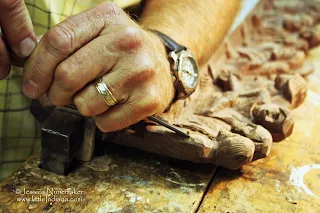What should you be looking for when buying handcrafted woodturning? Design and style is obviously very much personal thing and I cannot really advise on them. Certain things do stand out though and I will try and point these out.
With today’s modern equipment you should be wary of any woodturning that has screw holes in the bottom as this is something that is really unnecessary. Also, look for marks on the wood left from tools or sanding etc. A good turner will not leave these and you will often wonder how on earth the object was turned.
Make sure that the finish used is suitable for its purpose. Many turners finish decorative work off with natural oil, which is fine, but if the object is going to be used extensively, check what it is as some oils that are used may not be suitable for the end purpose. Bowls that will be used for holding liquids such as stews and soups (wood keeps its heat wonderfully) should be finished with food-safe oil and simply rinsed out and re-oiled after use. Goblets should be finished with something like a melamine finish, at least on the inside, as this puts on a liquid-proof coating, which renders the wood both safe and liquid proof. Be aware that if you use a goblet for red wine, no matter what finish is used, it will eventually stain.
Beeswax is perhaps the simplest and safest finish of all. It’s natural (not one of your silicone-based ones) and is the traditional way of sealing the wood. If the item has been sanded properly it should look polished with no finish on it at all; the finish should be purely there as a protection, not to make it look better.
The woods used can also be something to be careful of. Theoretically, almost any wood can be used to make something, but it may not be a suitable choice for the object. A good example is wood chosen for food items. Chopping boards, mortar and pestles, goblets, cups, food bowls etc., should all be made from a wood that is safe. The traditional woods are beech and sycamore. Some woods, such as yew and laburnum, are actually poisonous and should never be used for this type of work. Fruit woods are generally pretty safe as well but can be prone to splitting if they are wet and then dry too often. If you aren’t sure of what the wood is, ask. If the turner doesn’t know, don’t take the risk.
Wood can be turned wet, with the sap still in it, or dry. Be aware that wood is a natural product and never actually dries totally. It will continually take on or lose moisture and will flex accordingly. Taking a piece of turned wood from a turner's workshop and putting it on the shelf above your radiator almost guarantees that it will split as it dries out further. Any turner worth his salt will make sure that the wood has been acclimatised to his or her own home for a period before selling it on, but many hobbyists who sell their work don’t always think of this, and it can have disastrous consequences.
Be wary of rubber wood things which you can buy in supermarkets. Apart from the fact that they are often machine made in questionable conditions overseas, they are usually laminated, and made of a number of pieces glued together. Whilst this is fine for decorative work, the cheap imports are likely to fall apart after being used and washed over a period of time.
Finally, if you are after an exotic wood from a tropical country, spare a thought for this fact: many trees nowadays are in danger of extinction through overuse. A classic example is a Spanish mahogany, which was so popular at one time, that many trees were cut down. Many wood turners only use exotic woods if we know they are coming from a legitimate ‘farmed’ situation or, as in my case, by recycling old furniture and fittings. Sadly some of the most beautiful woods are in this category.
There are some wonderful pieces of woodturning out there made by skilful craftsmen. Don’t be tempted to buy cheap imports or thrown together objects. You’ll regret it. A good, well made object will outlast you and become a family heirloom.
Pete M-Jury
For more information visit: www.bodrighy.co.uk
